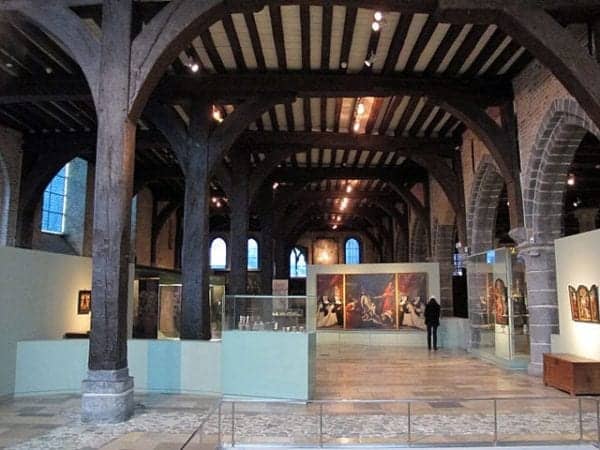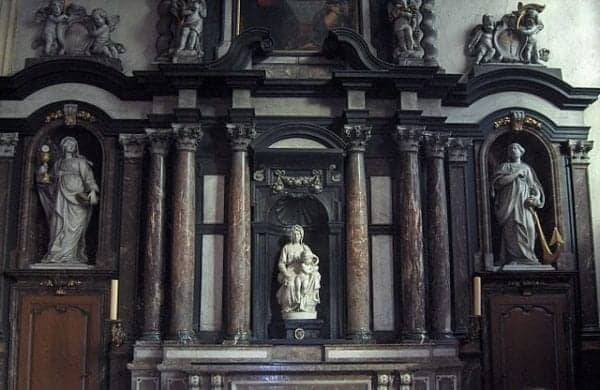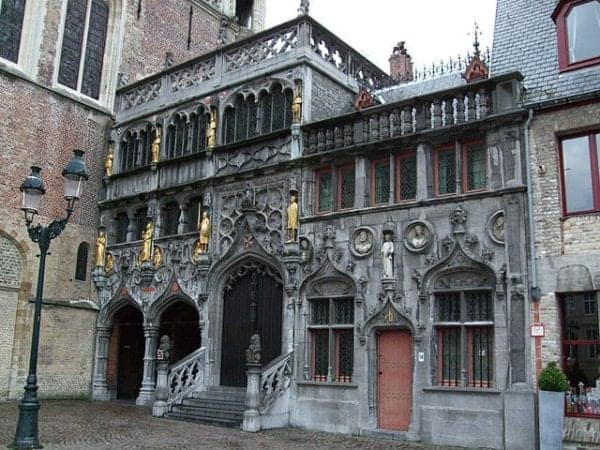This post is a free, self-guided walking tour of Bruges historic centre, along with a downloadable map with our suggested route.
You can complete this tour in 60-90 minutes, but you may want to take more time to explore the area and see as much as possible.
Click the map to enlarge
This tour can also be done as an audio tour.

Here is how it works:
- Download the tour on our Booking Page.
- Get a confirmation Email with .mp3, .pdf and embeddable map
- Enjoy the tour (s)
Even if you don't download any tours, you will still have access to valuable information on sightseeing, eating and playing in Prague.
Listen to a sample of our Bruges Historic Center Tour.
Available Tours:
- Historic Central Bruges
INTRODUCTION
Bruges is one of the most well-known cities in Belgium, and in fact in all of Europe.
This city has a history dating back thousands of years, so there are a lot of notable landmarks worth visiting.
This tour will take you to dozens of the most historic locations in the city centre, and we will also point out some of the more popular breweries, chocolatiers, and other businesses you may want to discover.
In addition to learning about the history of Bruges, this tour will also take you to one of the most photographed locations in the world and show you a somewhat offbeat way to get there.
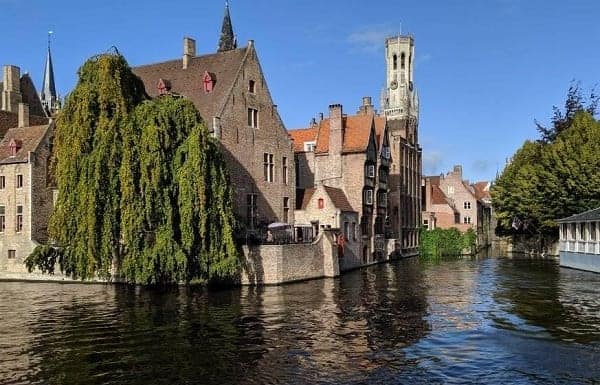
Experience both the hustle and bustle of large public squares as well as the more charming side of this city which you’ll discover as you walk along the canals of the river.
We will begin the tour at Market Square and circle around the centre of Bruges, returning at the end to the same location.
You can expect to visit at least 13 historic sites along the way. The map located above can be downloaded to your phone.
This tour will cover approximately 1.6 kilometers (around 1 mile) of the city centre in Bruges.
Thankfully, there aren’t many stairs to navigate, but you will have to cross two bridges on your way around the city.
There are also several free walking tours of Bruges that run daily if you would like to have a live tour guide.
1. Market Square
Take a look around Market Square to see some of the most notable sites in the city before heading out on this adventure.
Not only can you see historic buildings like the Belfry and the Provincial Court, but you’ll also experience some of the culture on display in Bruges.

Market Square has been a marketplace since the year 958, and to this day they still hold an open market on Wednesdays where you can purchase fresh fruit, vegetables, meats, cheese, flowers, and more.
The Wednesday markets run from 8 am - 1 pm each week, so if you’re here in the morning on the right day, you may even have a chance to do some shopping while you’re in this area.
In addition to its history as one of the predominant sources of commerce in Bruges, this location is also home to a prominent statue featuring two historic figures.

This statue depicts Jan Braydel and Pieter de Coninck, two heroes who fought for freedom against the French in the 14th century.
Both Breydel and Coninck participated in multiple attacks on French garrisons from 1302-1309 during the Franco-Flemish War, and they also supported the troops in other ways.
You can find out more about their story by reading the historic novel “The Lion of Flanders.”
Both statues were erected in 1887 in response to the artistic era of Romanticism, a nostalgic period which encouraged the glorification of important historic moments.
If you look to the East from the centre of this square, you will see the historic Provincial Palace, built in the neo-Gothic architectural style starting in 1887 and having been completed in 1921.

Provincial Palace
To the left of the palace is a museum known as the Historium, and this is a great attraction to visit if you want to know more about what life was like in Bruges during the medieval period.
While you’re walking around Market Square, you may notice a horse-drawn carriage here and there, and you can actually go for a ride around the city center on these wonderful vehicles.
Our next stop is at the Southern end of the square, so start moving in this direction when you’re ready to move on.
2. The Belfry
Standing 83 metres (272 ft.) high, the Belfry is one of the most historic buildings in all of Bruges and it has actually been designated a UNESCO World Heritage Site.
Although it was originally built around the year 1240, there was a fire in 1280 which required the tower to be rebuilt. Sadly, this was the site of the city archives, and they were lost in the fire.

The octagonal upper area of the Belfry was added sometime between 1483-1487 and capped with a wooden spire that bore the image of St. Michael.
Unfortunately, the spire eventually attracted a lightning bolt in 1493 which destroyed it and the bells in the tower.
Although they would replace it once again, the new spire was also destroyed in 1741, and they never bothered replacing it after that.

While the Belfry is much shorter today due to the lack of a spire, you can probably see the Gothic era-inspired stone parapet at the top of the structure today which was added to the rooftop in 1822.
Much of this building and its architectural style dates back to the medieval period, but the rooftop features a somewhat different type of architecture, which makes this Belfry an excellent example of mixed artistic styles.
During the 16th century, a carillon was added to the tower which allowed the bells to be played like a musical instrument with a keyboard.
The bells at the top of this tower have been used for a variety of purposes over the centuries, including the announcement of the time, work hours, political/religious events, and even ironically as a fire alarm.
The carillon has had a different number of bells at different periods in its history. In 1675, there were 35 bells. By the end of the 19th century, there were 48 bells. Today there are only 47.
While some bells are as light as 2 pounds, others weigh up to 11,000 pounds. The differences between each bell allow the Belfry to play many different tones through the carillon.
The music played by the carillon changes every two years, and the tunes chosen are often based on a theme of some sort.
From 2014 - 2016, the music was themed after songs that were popular during WW1 in order to celebrate the centennial of the war.
There are carillon concerts held here throughout the summer, and we recommend checking their calendar to see if there will be a concert during your visit to Bruges.
If you’re interested in learning more about the Belfry or seeing it from the inside, tickets are available to enter the building and see the bells, the carillon, the treasury, and even the view from the tower.
Tickets are €12 for adults or €10 for seniors, students, and young adults from the age of 6 - 25. Children 5 and under are welcome to enter for free with an adult.
https://www.museabrugge.be/en/visit-our-museums/our-museums-and-monuments/belfort
And for fans of the film, In Bruges, this is indeed the tower that elder hitman falls to his ultimate death from.
From here, the next stop on our tour will take you Southwest down the Steenstraat on the way to the St. Saviour’s Cathedral.
If you’re interested in shopping, you’ll find quite a few popular stores along this street including a Swatch store, Tommy Hilfiger, Swarovski, H&M, and many others.
3. Simon Stevin Statue
As you head down Steenstrat, you’ll be surrounded by a variety of different businesses until you eventually see a clearing on the left surrounded by trees.
This is a somewhat smaller public area than the Market Square, but one of the first things you’ll probably notice are street food vendors and some small amusement rides for children.

Behind all of these structures, you’ll discover a statue at the centre. This is a statue of Simon Stevin, a very important historical figure who was born right here in Bruges.
Stevin was the mathematician who proved the law of equilibrium on an inclined plane, which was an important moment in the history of science and mathematics.
He also contributed to our understanding of physics, geometry, chemistry, and even mechanics. One of his biggest contributions was to help spread the use of decimals in Europe.
He was also known for contributing to the science of how music is both written and understood by presenting his theory for the division of the octave into 12 equal intervals.
Unless you want to purchase a snack while you’re here, there isn’t much else to see in this public square, and there are quite a few small restaurants in the area, so this could be a good place to take a break.
When you’re ready to continue the tour, you can either continue Southwest on Steenstraat or walk South of the Simon Stevinplein Square to Sint-Salvatorskoorstraat.
Both streets will take you to St. Saviour’s Cathedral, but we recommend returning to Steenstraat if you want to see the front of the church first.
4. St. Saviour’s Cathedral
St. Saviour’s Cathedral is the oldest parish church in Bruges, dating back to the 10th century.
Sadly, this structure was destroyed by a fire early on and rebuilt between the 13th - 14th centuries.

For hundreds of years, St. Saviour’s Cathedral has been the central religious building in the city, and it remains one of the most historically relevant religious sites.
Although there are many other churches in the city, this is the main cathedral of Bruges, and it was granted that status in the 19th century.
The roof is one of the newest architectural additions to the church, as it was redesigned after it collapsed during a fire in 1839.
Although the architect they put in charge of this reconstruction was known for his neo-Gothic restoration, Robert Chantrell chose instead to use a Romanesque-revival design for the new roof.
This cathedral is also home to several medieval tombs, a rich collection of Flemish paintings dating from the 14th - 18th century, as well as some 18th-century tapestries.

St. Saviour’s Cathedral is open to the public most of the year, and you can visit Monday through Friday from 10 am - 13:00 (1 pm) or 14:00 (2 pm) to 17:30 (5:30 pm).
If you want to visit on the weekend, the church is open from 10 am 0 13:00 (1 pm) or 14:00 (2 pm) - 15:30 (3:30 pm) on Saturday and from 11:30 am - 12 pm or 14:00 (2 pm) - 17:00 (5 pm) on Sunday.
When you’re done at the cathedral, please circle around the building on Sint-Salvatorskerkhof to enjoy a good look at the entire structure as you head toward our next destination.
Head back up Sint-Salvatorskoorstraat to visit a few more stores along the way. Walk back up to the Simon Stevinplein Square and then walk down Mariastraat.
Head further South on Mariastraat to find the Depla Chocolatier where you can pick up a few sweets before continuing your tour.
5. Depla Chocolatier
Bruges is home to several fantastic chocolatiers including Depla, who has been making a variety of sweet treats since 1958.
Belgian chocolate is notable because it has more cocoa and cocoa butter than is typically used, and it’s also required to be produced finely enough that it will melt in your mouth.

Depla is an official manufacturer of the Bruges Swan, a special type of chocolate made in dark, milk, or white varieties which is only available in this city.
The exact recipe used to make this unique treat is still a secret, and there’s no other way to get it, so we recommend stopping in to try some for yourself.
Depla also sells a variety of other products including truffles, pralines, florentines, mendiants (chocolate over dried fruit or nuts), tuiles, and more.
If you’re interested in trying some authentic Belgian chocolate, this is an excellent opportunity to take a short break and grab a few sweets at one of the best chocolatiers in Bruges.
When you’re finished at Depla, head South until you reach the intersection with Guido Gezelleplein to find the next stop on our tour.
6. Gruuthuse Hof
Dating back to 1751, this is one of the oldest restaurants in the entire city, and it remains in business to this day.
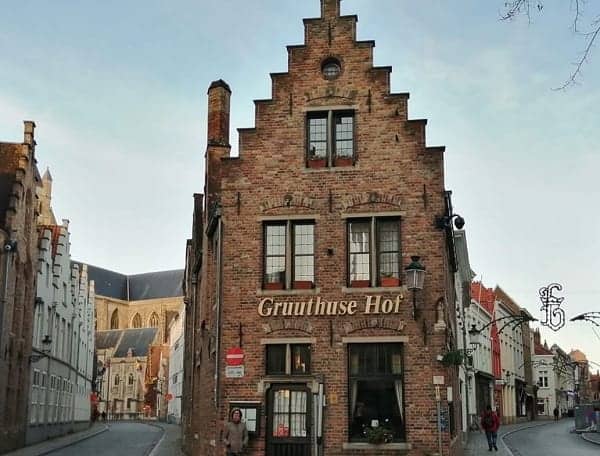
Many consider a meal at Gruuthuse Hof a prerequisite when visiting Bruges, and for good reason.
They still serve a menu full of Belgian favorites such as Flemish beef stew, shrimp or cheese croquettes, and of course a variety of Belgian chocolate items.
This menu can give you a good sense of the kind of food that is most popular in this part of the world.
If you go inside, you’ll see that they still have an old wood-beamed ceiling which is representative of the roots of this restaurant, but that’s the only thing that really looks old in the building.
One of the nice things about this location is that despite its age and history, Gruuthuse Hof is still a family-friendly restaurant that isn’t focused only on high-class dining.
While their menu is a bit pricier than some of the other restaurants you’ll find in Bruges, prices aren’t so wildly expensive that you’d want to avoid dining here.
You can expect prices for most meals to run from €15 - €25. They get 4.5 out of 5-stars on TripAdvisor.
That all said, if you’re not interested in getting something to eat, we recommend continuing the tour by heading to our next stop, St. John’s Hospital.
Continue walking South on Mariastraat to reach this destination.
7. St. John’s Hospital
As you walk down Mariastraat from Gruuthuse Hof, you’ll eventually see a rather large building on the left.
But, that’s actually the stop after this one – you’ll actually want to turn to the right to see St. John’s Hospital.
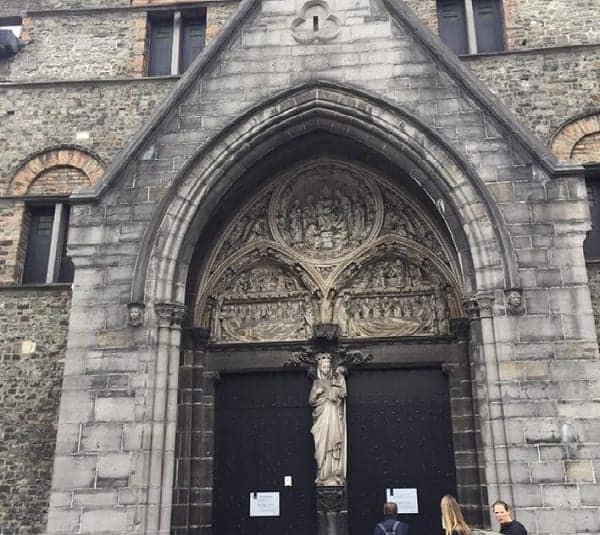
If you walk about halfway down the street, you’ll eventually run into an arched walkway which will lead to this historic building.
Old St. John’s Hospital was founded in the 12th century, making it one of the oldest hospitals not only in Bruges but in all of Europe.
The oldest remaining aspects of the building date back to the 13th and 14th centuries.
During the middle ages, this building was used to house and care for sick pilgrims and travelers.
The halls of the medieval hospital now contain a mixture of both gothic and Romanesque architecture.
Between the 15th - 19th centuries, St. John’s Hospital was expanded with the addition of both a monastery and a convent.
During the 19th century, they added 8 new wards to the central structure.
Old St. John's Hospital Museum
As you walk around the building, you’ll probably notice the hodgepodge of architectural styles on display from all of the different eras in which the hospital was expanded.
Old St. John’s Hospital remained in use until 1977, which means that they served the public for roughly 800 years before shutting down.
At this time, a newer, more modern hospital was built nearby to replace the centuries-old structure.
Thankfully, this hospital was never torn down, and if you want to learn more about it, there is a museum dedicated to St. John’s Hospital at the Southern end of the complex.
You can reach the St. John’s Hospital Museum by heading back out to Mariastraat and walking South just a bit. The next door you find on the right will lead to the museum.
Admission to both the hospital and museum will cost €12 for adults and €10 for seniors, students, and young adults from the age of 18-25.
Children 17 or younger are welcome to visit for free with a parental guardian.
The next stop on our tour is just across the street, and as we mentioned before, you’ve probably noticed at least one of its structures looming overhead.
When you’re ready, go ahead and cross the street to see the Church of Our Lady.
8. Church of Our Lady
This beautiful religious structure was originally crafted in the 13th century, with additions being made every now and then throughout the next few centuries.

The tower of this church is 115.6 metres (380 ft.) high, and it’s the tallest building in all of Bruges. Its tower is also the second tallest brickwork in the entire world.
Unlike some of the other structures in Bruges which have undergone many renovations due to fires and other issues, the Church of Our Lady retains much of its original gothic architecture.
One of the most notable examples is the flying buttresses which were constructed in the late 13th century.
Inside, the nave has a cross-vault ceiling and black & white tiled flooring.
Along the side-aisles and chancel of the interior, you’ll notice the baroque style of architecture at play in much of the design.
Several famous people are buried here including Charles the Bold, the last Valois Duke of Burgundy, and the duchess Mary.
The Church of Our Lady is also well known for its sculpture of the Madonna and Child which was created by none other than Michelangelo in 1504.
The statue is enshrined in the altarpiece of the Cappella sacra chapel. If it seems like a piece of this magnitude is a bit out of place in Bruges, there’s an interesting story behind that.
According to historians, the Madonna and Child were probably intended to be housed at the Siena Cathedral in Italy.
However, it was instead purchased by two Bruges merchants, Jan and Alexander Mouscron, who would donate it to the church in 1514.
This was the only sculpture Michelangelo ever created which was taken out of Italy during his lifetime.
If you want to see this piece, you’ll have to pay for access to the museum.
Ticket prices are very reasonable at a cost of just €6 for adults and €5 for seniors, students, and young adults from the age of 18-25. Children are granted free access with a parental guardian.
The museum is open Monday through Saturday from 9 am to 17:00 (5 pm). You can also visit on Sundays from 13:30 (1:30 pm) to 17:00 (5 pm).
Our next stop will be across the bridge to the South of the Church of Our Lady.
Keep walking down Mariastraat, cross the bridge, and keep going until you reach the intersection of Katelijnestraat and Walstraat.
This road is lined with a variety of restaurants, chocolatiers, and other shops.
If you’re hungry, this might be a good place to stop for a bite. That said, if you’d rather have some fresh seafood, you’ll find an even better stop later on this tour.
Once you reach Walstraat, turn right and walk Southwest until you reach the intersection of Walstraat and Walplein.
Turn left on Walplein and walk South down this street until you reach our next stop, the De Halve Maan Brewery.
9. De Halve Maan Brewery
The De Halve Maan Brewery is around 500 years old, but they’re also home to one of the more interesting new additions in Bruges.

In 2016, the brewery installed a 3.2-kilometer pipeline which leads to a bottling plant in the suburbs. Most of us have heard of oil pipelines, but whoever would have thought there would be a beer pipeline?
This pipe was installed to fix a logistical problem that the business had run into. In recent years, De Halve Maan Brewery has become quite popular, which meant sending trucks of beer out through these cobblestone streets on a daily basis.
To cut back on those costs, the pipeline was installed. Now all of their beer can be bottled in another location 3.2 kilometers away, allowing them to avoid all the traffic and tourism which comes into the downtown area.
The current brewery at this location has been in operation since 1856, and it has been in the same family for five generations.
The De Halve Maan Brewery is open at various times throughout the week, and they offer tours as well as lunch and dinner visits. Visit the website.
Our next stop will be right behind the Church of Our Lady, so you’ll need to return the way you came. Walk Northeast on Walstraat until you reach Katelijnestraat and turn left.
From here, walk Northwest on Katelijnestraat which will turn into Mariastraat, and cross back over the bridge.
Once you’re back on the right side of the river, turn right when you reach O.L. Vrouwekerkhof-Zuid, the road just ahead of the Church of Our Lady, and head to the back of the building.
You’ll know you’re on the right track when you see the Gruuthusemuseum in front of you. This museum houses a lot of historic furnishings, and it is located inside a former palace.
Once you reach the end of this path, there will be a fork in the road. Turn right and head toward the bridge.
10. Bonifacius Bridge
Although there are several ways to cross the water in this part of the city, this small, tucked-away bridge behind the church is widely considered to be one of the most scenic and romantic locations in the city.
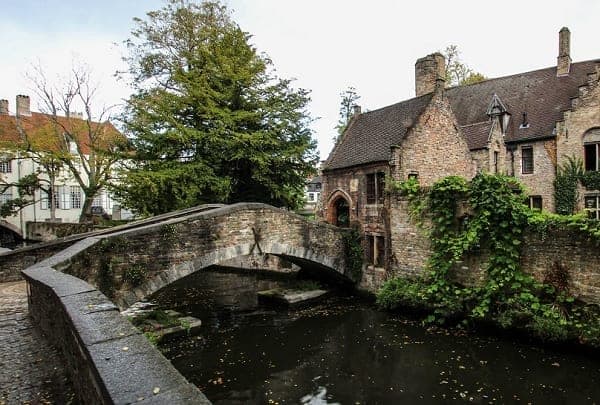
This off the beaten path is great to enjoy the quiet views of both the canal and the Church of Our Lady, as well as tour boats passing underneath.
Although the bridge itself may look ancient, it’s actually one of the newer structures in Bruges, as it was constructed in the early 20th century.
When you’re ready to continue on, keep walking east past the bridge and away from the church into the Arentshof park.
There are a lot of sculptures in this area, and if you look just South of here you’ll see a gated archway that leads to Groeninge street, and the first notable shop in this area is The Bear Necessities toy store.

If you’re bringing children along for this tour, or if you want to get a nice souvenir for some kids at home, we recommend making a stop here to see some of their unique teddy bears.
To reach the next stop on our tour, head Northwest through Arentshof Park until you reach Dijver Road. When you get to the street, you’ll see the Arentshuis museum to the left and the museum’s shop to the right.
This museum houses a lot of artwork, primarily focused on the works of Frank Brangwyn, which includes paintings, drawings, watercolors, furniture, pottery, and even carpets.
If you’re interested, ticket prices are €6 for adults, €5 for seniors, students, and young adults from the age of 18-25. Children 17 and under get in for free.
From here, turn right and head down Dijver Road to reach our next destination which you’ll see on the left.
11. Dijver Park/Flea Market
Located alongside the water, Dijver Park is home to the Bruges flea market which is open every day of the year.
Even if you don’t feel like doing any shopping, you may want to take a look around to see the variety of items for sale in the area.
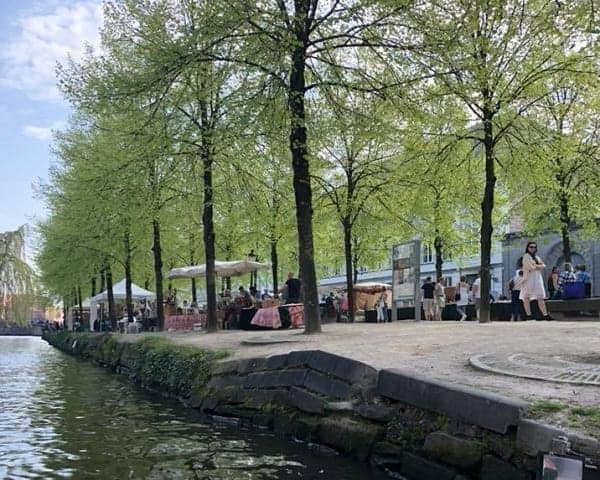
You can expect to find paintings, furniture, toys, and many other interesting knick-knacks.
This flea market is open from March through November every Saturday and Sunday from 10 am - 18:00 (6 pm).
This is also just a nice place to enjoy views of the water and spend some time soaking in the local culture, experiencing the social fabric of the city.
Whether or not you’re planning to spend any money here, you’ll find the next stop on this tour by continuing Northeast along Dijver Road.
Once you reach a four-way stop, continue Northeast on Rozenhoedkaai Road.
12. Quay of the Rosary
As you walk up the Rozenhoedkaai Road, make sure to pay close attention to the view on your left. When you come to the bend in the river, you’ll reach the Quay of the Rosary.
This is one of the most photographed locations in not only Bruges but the entire world. If you’ve seen images of this city before, chances are one of them depicted this exact site.

The Quay of the Rosary was likely the site where salt traders would dock and either load or unload their goods during the middle ages. At the time, salt was a valuable and important commodity in Bruges.
It’s not difficult to see why this would be such a popular stop to take a few photos, because this is certainly one of the most picturesque views in the entire city.
If you haven’t already pulled out your smartphone or camera to take your own photo, we highly recommend taking a few minutes to get a good shot of the Quay of the Rosary.
Many travelers recommend seeing this location during the evening if possible, as the area is well lit and the view produced after dark is often described as unforgettable.
Once you’re done taking a look around and enjoying a few excellent photo opportunities, continue walking Northeast on Rozenhoedkaai Road. This turns into Braambergstraat at the bend in the river.
Continue walking down Braambergstraat until you reach the intersection with Vismarkt.
13. Fish Market
By the time you reach the intersection of Braambergstraat and Vismarkt, chances are you’ll already be smelling something a little fishy.
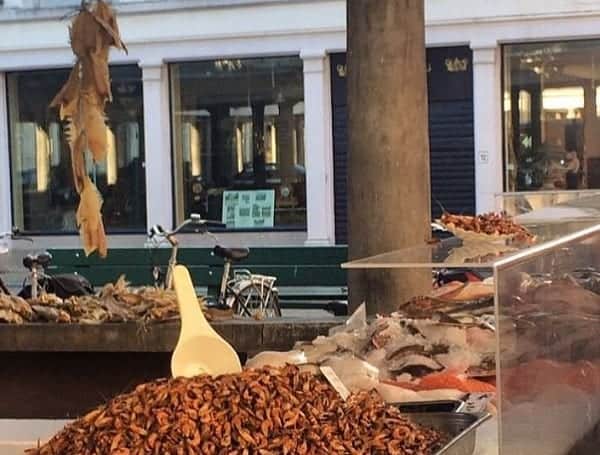
Whether or not you choose to let your nose guide you, you’ll find the historic Fish Market on the left-hand corner of this junction.
Although there was an open-air fish market in this area during the middle ages, the official market you see today was constructed in 1821 and it bears a coat of arms with two entwined fish under a crown.
The fish market is open every morning from Tuesday through Saturday, so depending on when you visit, you might not actually hear or smell much of anything.
That said, if you come when the market is open, the experience should be pretty interesting.
You can expect to see a wide variety of fish for sale at the market including locally caught seafood like flounder and sole as well as some herring, mackerel, cod, haddock, and grey prawns.
Even if you don’t plan to purchase anything here, you can expect local restaurants to sell these types of freshly-caught fish.
If you want to find a restaurant that receives their fish from this market, consider asking one of the vendors for this information.
The fish salesmen who work here every week take a variety of different approaches to selling their wares, so you can expect to hear a lot of interesting things from them as you walk by.
If you’re in the mood to try some of their fish, many stands bordering the market provide takeaway dishes that you can enjoy while continuing your tour.
There are also several restaurants selling a variety of seafood in the area, so this might be another great location to stop for a meal if you haven’t done so already.
When you’re done, head Northwest on the Vismarkt road toward the water and cross the bridge to find our next stop.
As you pass through the alleyway on the other side, you’ll eventually walk through a large and ornate archway adorned with statuettes of saints at the top.
This is the first significant and eye-catching attraction you will see which is actually part of our next stop.
14. Bruges City Hall & Courthouse
Once you’ve passed through the archway, turn around to see two rather large buildings to both your right and your left which are actually connected.
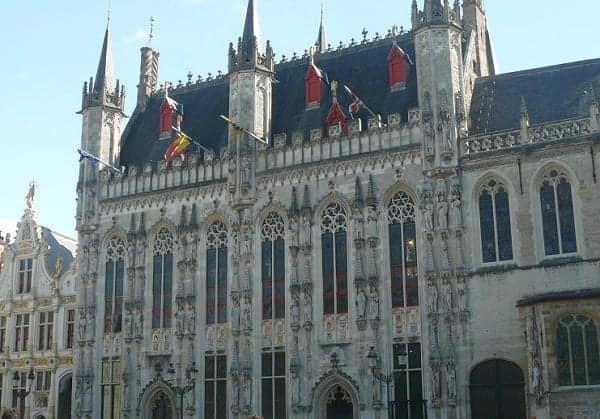
The building on the left is actually the former location of the Bruges City Hall. Construction of this landmark was started in 1376 and it was eventually completed in 1421.
The architectural style used for Bruges City Hall was inspired largely by the Gothic movement.
Take a moment to look closely at the niches for each window and you’ll notice they’re all almost exactly the same.
This is actually an architectural touch known as the “Brugian span” and named after Gothic architecture which was typically found in Bruges.
Bruges City Hall is one of the oldest examples of a statehouse in the Low Countries with over 600 years of history serving as a government building.
Even today, this is one of the most important political sites in the entire city, and they still hold city council meetings in the Gothic Hall.
In addition to serving a purpose for the city government in modern times, this building also houses a lot of interesting historical artifacts and artwork.
Admission to the Bruges City Hall museum is €6 for adults and €5 for seniors, students, and young adults from the age of 18-25. Children 17 and younger get in for free.
The courthouse, otherwise known as Brugse Vrije (or Liberty of Bruges), can be found to the left of the City Hall and it served the purpose of court of law between the years of 1795 - 1984.
Sitting atop the building you’ll see a golden statue of Lady Justice, holding out her scale for the world to see.
Much like the city hall, there are a lot more examples of artwork and noteworthy artifacts inside the building.
Brugse Vrije has also become a museum, and you can expect to pay the same prices to enter this location. Both museums are open daily from 9:30 am - 17:00 (5 pm).
You’ll find the next stop on our tour simply by walking Southwest through Burg Plaza which is located in front of Bruges City Hall.
There’s just one more site we want you to see before returning to Market Square!
15. Basilica of the Holy Blood
If you walk alongside Bruges City Hall heading Southwest through the plaza, you’ll eventually run into this historic church.
This is actually one of the oldest churches in the entire city, dating back to the year 1134. Although it’s not the biggest church in Bruges, it’s still a pretty historic location.
Although it was originally built to be the chapel of the Count of Flanders, this site was promoted to a minor basilica in 1923.
This church houses a relic of the Holy Blood which is said to have been gathered by Joseph of Arimathea, and it is located in the upper chapel.
The lower chapel is dedicated to St. Basil the Great.
While the lower chapel is an excellent example of Romanesque architectural structure, the upper chapel has been rebuilt and renovated multiple times in the Gothic and Gothic Revival style.
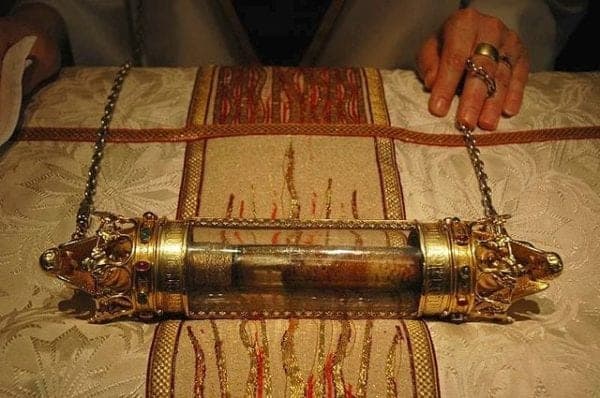
The St. Basil Chapel houses a wooden sculpture of the seated Madonna and Child. Jesus on the Cold Stone and the Pieta.
There are also relics of St. Basil and Blessed Charles the Good to the left of the choir.
The Chapel of the Holy Blood is at the top of a staircase which is ornamented with gilded bronze statues representing many notable figures from throughout Flemish history.
There’s a large wall-painting behind the high altar which depicts Christ shedding his blood with the towns of Bethlehem and Jerusalem in the background, representing two of the most important locations in his life.
The lower half of the painting depicts the transport of the relic of the Holy Blood from Jerusalem to Bruges.
The relic itself is contained in a vial and kept in a silver tabernacle in the chapel.
Whether or not you choose to go inside the church, there are a few other places you may want to visit in the area while on the way back to Market Square.
Bruges Beer Experience and Other Attractions
Head North of Burg Square until you reach Breidelstraat. Once you reach this street, start walking West.
Breidelstraat is lined with many interesting shops and restaurants including a few jewelers, a Stefs Chocolatier, and a souvenir store.
One of the most interesting things to see in this area is the Bruges Beer Experience, which is an interactive museum covering the history of beer in the area.
In addition to learning about how beer is made and the role it has played in the history of this city, you’ll also have an opportunity to sample some of the best brews in Bruges.
Once you are finished looking around these shops, continue West on Breidelstraat until you reach Wollestraat.
At this point, you’ll be able to see both the Belfry and Market Square once more, which will complete our tour.
OTHER CITIES
Be sure to check out our guided free tours of Bruges. Free Tours by Foot is also present in most European cities. Here are just a few below.
Check out our tours in Florence, Rome, Paris, Prague, London, Lisbon, Berlin, Amsterdam, Barcelona, and dozens of more cities.



